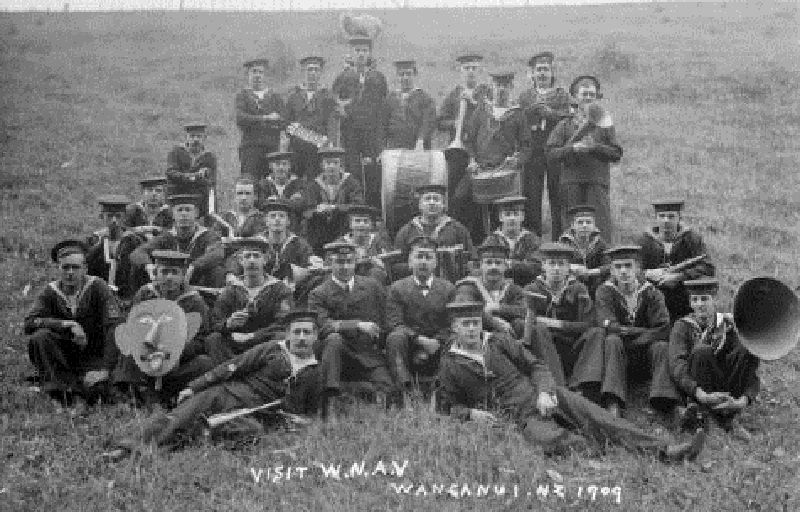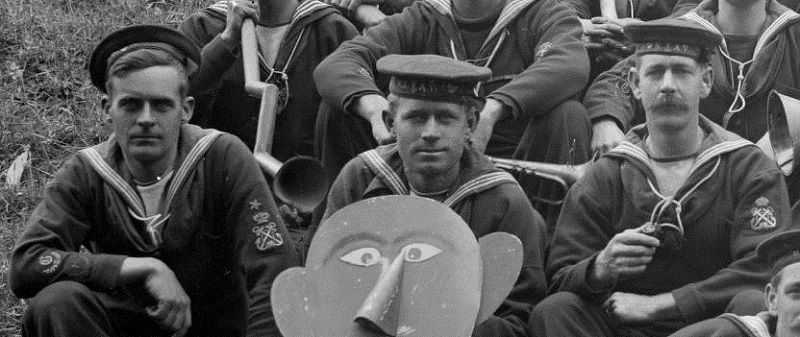
 |
Recent Books by Forum Members |

 |
 |
|
|
|||||||
 |
|
|
Thread Tools | Display Modes |
|
#1
|
||||
|
||||
|
Some time ago on the forum there was a discussion re a King's Crown Royal Navy officer's cap badge which had the letters 'NAV' above the anchor and below the crown. The general opinion was that the letters referred to 'Naval Artillery Volunteers' but beyond that no-one could be more specific. The possibility of it being linked to the Royal Naval Artillery Volunteers (RNAV) was raised but since they only existed between 1873-1892, and therefore would only have had a Victorian Queen's Crown cap badge, this suggestion was rejected. No definite identification of the badge was made.
Recently, whilst undertaking some research into the RNAV I came across a possible solution to this mystery. It is very possible that this was the cap badge of officers in the New Zealand Naval Artillery Volunteers. The first Naval Volunteer units were founded in Auckland and Nelson in 1858. Over the rest of the 19th century Naval Volunteer units were formed in various ports , such as Wanganui and Wairoa. These were reorganised into the Naval Artillery Volunteers in 1883. Volunteers, or 'Navals', peaked in the 1880s with a total of 20 units. The organisation and role of these NAV units was very similar to that of the RNAV in the UK. Volunteers wore naval uniform, were trained in boats, taught signalling and gunnery, and manned batteries at the main ports. Despite this, the NAV actually came under Army control. In 1902 the NAV were renamed the Garrison Artillery Volunteers and within a few years had become part of New Zealand's Territorial Army. However, it is significant that the NAV survived long enough to have adopted King's Crown badges. Unfortunately I have been unable to find any good examples of NAV uniforms preserved in naval museums in New Zealand. The only items I have found credited to the NAV were a pair of shoulder boards for a Captain RNR (1891-1901) and a dress coat for a Captain RN. Both of these items could have belonged to officers who served in the NAV but are not specific to the NAV. Apart from the RNAV and the New Zealand NAV, the only other unit I have found with NAV in its title is the New South Wales Naval Artillery Volunteers. This unit was part of the NSW Naval Brigade and was formed about 1880 but had ceased to exist by the time the Commonwealth of Australia was formed. No King's Crown cap badges were ever worn by this unit. The above highlights the problems faced by Victorian RN collectors - there are numerous 'variations on a theme' to be found amongst the various colonial naval forces in the 19th century. The situation is not helped by the lack of information to be found about these units. For instance, I have two Victorian naval officers belt buckles (one normal size and one smaller 'Midshipman's' issue), lined background and identical to RN buckles in every way except one - instead of being 'gold' they are silver-plated bronze. It took me a long time to confirm that these had been worn by officers in the Victorian Naval Forces from the colony of Victoria, Australia. Apparently everything that would be gold on an RN officers uniform was silver in the Victorian Naval Forces - belt buckles, rank insignia, buttons, etc. However, it took me a long time to confirm this! Please excuse the rather long-winded lecture, but I felt that I should pass on this information in the hope that it might be of use in the future. One of the reasons I joined the forum was to share information. Included below are some examples of insignia I have in my photo archive. All images are reproduced with their original owners permission. Pete i). NSW Naval Artillery Volunteers buckle c.1882 (note the unusual Victorian Queen's Crown) ii). Jacket worn by members of the NSW NAV iii). Rank insignia worn by the NSW NAV iv). Coat worn by officer of the RNAV v). Close-up of RNAV insignia |
|
#2
|
|||
|
|||
|
Hi Pete
Good news to hear the question of the badge has been solved and a great lot of information as well. I am sure it will be of great interest to a lot of naval collectors. David |
|
#3
|
||||
|
||||
|
Well done Pete, that is the type of research I truly applaud.
Best wishes, John
__________________
Keep the flame lily burning |
|
#4
|
||||
|
||||
|
Hi David and John
Many thanks for your kind comments. Pete |
|
#5
|
||||
|
||||
|
Since undertaking the research outlined above I have been sent images of various units of the NZ Naval Artillery Volunteers: -
i). Port Chalmers Naval Artillery Volunteers (i) ii). Port Chalmers Naval Artillery Volunteers (ii) iii). Thames Naval Artillery Volunteers and Band, 1898 iv). Wellington Naval Artillery Volunteers, 1890s v). Wellington Naval Artillery Volunteers, c.1900 Pete |
|
#6
|
||||
|
||||
|
Hi Pete,
My Great grandfather served with the Wellington Navals so I am very interested in the subject of the New Zealand Naval Artillery Volunteers that were connected to the Wellington region. Unfortunately as yet there is no book dedicated to NZ Volunteer uniforms (pre 1911), however the good news is that book writers Tim Ryan and Peter Cooke are currently working together to produce such a book. The evolution of the Naval Volunteer units in New Zealand is too complex to put into a couple of paragraphs, but I would like to point out that Artillery in Auckland evolved from the Auckland Coastguard Volunteers which was the first Naval unit to be formed in New Zealand in 1858, and it wasn’t until later that they were reformed into the Auckland Naval Artillery Volunteers. The first Naval Artillery Volunteer Company in New Zealand was established in Nelson in June 1860 with William Akersten elected as the Company’s first Captain. As of the 1st January 1883, the New Zealand Volunteer Force was re-organised, where all units of Naval Volunteers were converted into Naval Artillery Volunteers. The strength of the New Zealand Volunteer force on the 1st July 1902 (exclusive of cadets), consisted of 8 companies of naval artillery and 3 companies of garrison artillery (Total of 946 men), as well as 5 field batteries (Total of 442 men) In January 1903 the Naval Artillery Volunteers and Garrison Artillery Volunteers were reformed into a Regiment of Garrison Artillery consisting of 10 companies. As such No. 1 and 2 Companies of the Wellington Naval Artillery Volunteers have were formed into one company, and designated as “No. 4 Company, New Zealand Garrison Artillery Volunteers (Wellington Naval Artillery Volunteers),” although it was more commonly referred to as ‘No.4 Company (Wellington) Naval Artillery Volunteers.’ The 1903 changes required new uniforms for the 10 companies, but probably due to costs of the volunteers having to purchase their own uniforms this was not enforced and only two of the Garrison Artillery companies purchased new uniforms. As far as I can tell, the Naval Artillery uniform and the name “Naval Artillery Volunteers” was still in use up until October 1911 when the Wellington Naval Artillery Volunteers were officially designated under the Defence Act as the “No.3 Territorial Garrison Artillery.” The following picture dated 1909 shows the Wellington Naval Artillery Volunteer band. Interestingly it shows a combination of Victorian and Kings crown being worn.    Brent |
|
#7
|
||||
|
||||
|
Hi 'Attila'
Many thanks for the information. Even with the internet it is extremely difficult to find anything about the NAV (especially from this side of the world!) so many thanks for your additional details and the great photos. I am very pleased to hear that something is finally to be published about NZ Volunteer Units. I was aware of the Coastguard Artillery link but since I was only providing a brief outline of the NAV I didn't include it in my earlier comments. It is good to have some confirmation of the brief details I already had discovered and the extra information is gratefully received. Although I am a dedicated RN collector I am also very interested in the various colonial Naval Units that existed throughout the Empire in the 19th and early-20th centuries. Although in recent years there has been more research undertaken into Army and Militia units there seems to have been very little research into the Naval side. More information on badges and insignia is certainly required, especially as these badges do turn up in the UK. I must admit that it has been especially interesting for me to discover the NZ NAV and I intend to try and find out more about them. Partly this is because as well as having strong links with the RN my family also has strong links with the RNZN and I actually have more family living in New Zealand than the UK. I think a visit to New Zealand is required to undertake some additional research! I would be extremely grateful if you could pm me when the new book is finally published . Many thanks again for getting in touch. Pete |
|
#8
|
||||
|
||||
|
I recently found these photos amongst some old Victorian photos. They are from the Bangor area and show the RNAV tally.
|
|
#9
|
|||
|
|||
|
Excellent info, thanks very much. Now, I wonder if there are any of the cap ribbons still around somewhere... Probably easier to find the teeth of a hen!
 Cheers, Alex |
|
#10
|
||||
|
||||
|
I have found a couple more pictures of members of the Royal Naval Artillery Volunteers which might be of interest.
The first image is particularly interesting because of the variety of positions and bows used for tying the tally. Strangely enough the tallies don't seem to have any letters on them - but this could simply be due to the quality of the picture. The second image shows men of the RNAV at Brighton. This image shows the tallies more clearly. The third image is an attempt to focus upon one of the tallies but it hasn't reproduced very well. Sorry about that! Incidentally, the original uniform instructions for the RNAV state: - 'The cap ribbon to have a crown and anchor in front, with the letters R.N. on one side of the anchor, and the letters A.V. on the other. The crown and anchor and letters to be embroidered in silver on a black silk ribbon. The letters to be five-eighths of an inch in size.' These tallies are incredibly rare. I have never seen one and, as far as I know, even the National Maritime Museum doesn't have one. However, I am sure that there must be one or two out there somewhere! Pete |
 |
|
|
 |